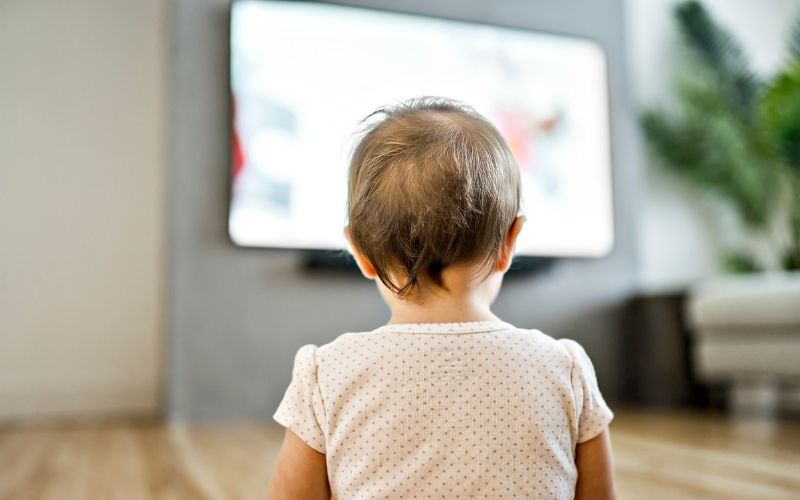Family Digital Wellness Guide
Birth to Preschool (Ages 0-5)
Build Healthy Habits from the Start

The early years of life are marked by tremendous growth and development, with young children learning about the world primarily through play, exploration, and close interactions with caregivers. After the age of two, digital media can be a helpful tool when used thoughtfully, but it should never take the place of vital activities like hands-on learning, imaginative play, and quality time with family. Ultimately, your engagement and guidance lay the foundation for a balanced and healthy relationship with technology.
- Research shows that young children benefit most from screen time when it’s intentional, age-appropriate, and shared with a trusted adult. Whether watching a short educational video together or exploring an interactive storybook app, co-viewing allows you to guide your child’s understanding and deepen your bond.
- Balancing the use of digital devices with other important aspects of childhood, such as physical activity and sleep, is critical at this stage. Establishing screen-free routines, such as unplugged family meals or keeping devices out of bedrooms, can create healthy boundaries early on, making it easier for children to understand that screens are just one part of life.
- When used thoughtfully, media can support connection and creativity, whether through video chats with loved ones or stories that reflect your child’s world.
Critically, young children learn by observing the adults around them. By modeling mindful and purposeful technology use yourself, you provide a powerful example that shapes their attitudes toward media as they grow.
Next section: What the Science Says
What the Science Says
Infants & Toddlers (Birth-2)
The first years of life are filled with rapid brain development, exploration, and learning as infants and toddlers engage with people and their environment. During their first months, babies begin to smile at their caregivers and imitate their expressions. They advance swiftly in their physical milestones such as sitting up, learning to crawl, and beginning to walk. By their first year, babies can understand more language and may begin to babble, imitate spoken language, or even say their first words as they learn to communicate with others.
As they enter their toddler phase, children start to develop more complex social skills and the concept of themselves in relation to others. They begin to enjoy more social play, first playing alongside other children, then engaging in mutual play. Their emotions become more complicated and can swing wildly as their exploration of the world becomes increasingly independent and intellectually complex.
Social interactions using technology can be important and stimulating for very young children. Grandparents or other family members unable to visit in person or between visits may use video chatting to create or grow family relationships, and may be a first step in using technology—a skill needed in our tech-saturated world.
Common Sense reports that children under 2 in the are spending most of their media time watching videos on TV, YouTube, or streaming services—when a child uses media on any given day, they spend about an hour and forty minutes on average watching TV and videos. But there is wide variation.
For infants and toddlers, media is used for a variety of reasons. Parents report that they mostly feel the amount of time their young child spends on media is about the right amount, and they are hopeful that their child’s media use helps them learn. At this age, a child’s brain has not yet developed to the point that they can learn from digital media as effectively as they learn from interacting with their caregivers and peers. Most babies and toddlers are likely better served in their learning by interaction with their physical world than with the digital environment.
In reality, parents and caregivers use media and devices much of the day for a number of reasons, many of which can be categorized as the demands of daily life. For many families, an environment completely free of technology and online media for their children is not realistic, especially as our world becomes increasingly digital.
While we recommend limiting screens at this age, we recognize that they can serve a purpose in our busy lives and we want to help you to use them well and in ways that can most benefit you and your developing child.
When your child is using media, try to interact with them or watch with them whenever possible—make it interactive by asking questions, pointing things out, or moving your body to music or songs in their favorite videos.
Ideal Use
For children under 18 months, try to limit the use of digital devices and media to video chatting with family and friends.
For toddlers, screen time can be expanded to include watching child-centered programming (see Best Practice, “Use clues to select interactive and educational media,” evaluating media) with an engaged parent or caregiver when possible.
Preschoolers (3-5)
Preschool children are becoming ever more independent, forming their own opinions, developing friendships outside of their family, and exploring the world around them. Children this age like to know what to expect and why.
- They are developing routines, learning rules, and displaying complex emotional reactions to situations.
- They are self-oriented and can engage in extensive make-believe situations, including imaginary friends and multiple self identities (even within short periods of time!).
- They begin to form relationships with others, navigating friendships, learning to regulate their emotions, and testing limits.
- They are rapidly developing their language skills alongside their social skills, with story-telling becoming increasingly important.
Preschoolers especially need interaction with their primary caregivers to learn and develop their social, emotional, and cognitive skills. At this age, children continue to learn best from interactions with others, physical play, and self-directed curiosity.
Although many guidelines for screen time exist, preschool-aged children spend an average of a little over 2 hours per day using screens, and online videos from platforms like YouTube are extremely popular for children this age.
To support their social, emotional, and academic development, or preschoolers, it is best to limit their screen time to prosocial media (positive media that helps them learn and grow) that encourages interaction such as answering questions. E-books, for example, should be used in a way that encourages discussion—focus on the story and let the tech features take a backseat, enhancing the experience instead of being the focus. For example, if an e-book encourages your child to touch a picture of an animal to find out what sound it makes, ask them to guess or imitate the sound before touching the image on screen.
Preschool children can engage productively with interactive media for short periods of time, with a particular focus on media that can be consumed with you, and in video chats with friends and loved ones.
While we continue to recommend limiting passive screen use at this age, we recognize that it can serve a purpose in our busy lives and we want to help you to use them well and in ways that can most benefit you and your preschooler. As with infants and toddlers, always consider what your preschooler is watching and learning and also experiences they might be missing because they are on a screen.
Ideal Use
For children ages 3-5, receptive screen time (such as watching videos) should be limited to their attention span for each viewing, and no more than 2 hours total per day.
Next section: Best Practices
Best Practices for Digital Wellness
The early years are a time of incredible growth and discovery. To help families navigate young children’s media use in ways that support healthy development, the Digital Wellness Lab organizes guidance around the 5 M’s of Digital Wellness: Model, Mentor, Monitor, Mastery, and Meaning.
Each “M” offers a different way you can guide, support, and share in your child’s digital experiences. Below, you’ll find practical tips tailored for infants, toddlers, and preschoolers, helping them build a balanced relationship with technology from the very start.
Model
Young children learn by watching you. Modeling healthy media habits—like putting away your phone during meals or choosing when to be offline—shows your child that screens are just one part of life.
- Limit your own screen time when you’re with your child. Children benefit most from your full attention. Research shows that when parents use more media, their children do too. And when technology interrupts parent-child interactions—like during playtime, diaper changes, or bedtime—it can lead to a higher likelihood of behavioral challenges in children. Make an effort to pause notifications, silence calls, and focus on your child when you’re together.
- Institute screen-free mealtimes. Shared meals are important moments for bonding, learning routines, and modeling healthy habits. Studies suggest that when devices are present at mealtime, children consume fewer healthy foods and may develop less nutritious eating patterns overall. Turn off the TV and keep phones and tablets out of the room so you can connect without distraction.
Mentor
Even babies and toddlers benefit when you help them understand what they see and hear. Mentoring at this age means sharing media experiences, talking about what’s on the screen, and making sure digital moments strengthen real-life connections.
- Encourage others to talk directly to your child. Young children who spoke to someone over video chat could recognize a person after a week and learned more. Video chats can also help build family relationships over distance. To make the experience more engaging, if the person you are doing the video call with points out something about your child (such as, “look at those strong legs!”), you can tickle or point to their legs. You can also “share” food through the screen, sing songs, play games, or repeat movements (such as hand clapping) to get your child to join in. Preschoolers may enjoy showing off their schoolwork, demonstrating new skills (“look what I can do!”), or telling stories.
- Celebrate representation and spark conversation. Select shows, movies, and books that feature a wide range of identities, cultures, and experiences—including differences in race, gender, language, and ability.
- Highlight similarities and differences in a positive way. As you engage with media together, use simple observations and questions to spark curiosity and build empathy. Noticing and talking about differences helps your child appreciate diversity while also recognizing what connects us. You might say:
“Your hair is very dark and Elsa’s is very light. It looks perfect on each of you!”
“Molly loves to go exploring in the woods just like you do!”
“Daniel Tiger calls his Grampy ‘Grandpere’. People sometimes use different words than we do, what do you think about that?”
Monitor
Young children rely on you to decide when, where, and how much media they use. Monitoring at this stage means setting boundaries around screen time, choosing age-appropriate content, and paying attention to how your child responds emotionally and behaviorally. For young children, measures that block certain features or limit where and for how long screens can be used may be most effective for supporting development and protecting against problematic use of media.
Most applications and devices offer parental controls that can help ensure a safer, more developmentally appropriate media experience.
- Enable filters and protections. To limit exposure to inappropriate content and create safer online environments, look for features like safe-search mode, ad blockers, and kid-specific versions of apps designed for children under 13.
- Use bookmarks and restricted profiles. Bookmark favorite sites and games to help your child navigate more independently within safe boundaries. Many platforms also offer child-specific profiles with customizable access.
- Find help when needed. If you’re unsure how to set up controls, check the Trust & Safety or Parent sections of the app’s or device’s website for guidance.
Attention spans vary by age, and not all content is engaging—or appropriate—for your child’s developmental stage. Attention span for video content tends to be much shorter than for other types of activities.
- Use developmental attention span as a guide. Young children’s attention spans are typically 2–3 minutes per year of age (e.g., a 2-year-old may focus for 4–6 minutes). If your child seems distracted or restless, it may be time to switch activities.
- Watch how they respond. Pay attention to your child’s facial expressions, body language, and behavior during and after screen time. These cues can tell you if the content is overstimulating, upsetting, or simply not engaging.
Screens can affect both the quantity and quality of children’s sleep.
- Power down early. Turn off screens at least an hour before bedtime or naps to help your child relax and get naturally sleepy.
- Keep devices out of the bedroom. Avoid placing TVs, tablets, or smartphones in your child’s sleeping area to create an environment that supports healthy sleep.
Mastery
As your child grows, they begin building early skills for using technology in healthy ways. Mastery at this age is about helping them interact with media with intention—like singing along, moving to music, or exploring new ideas together—rather than just watching passively.
Not all media labeled “educational” is backed by research—and young children are especially susceptible to media that feels engaging but may not support healthy development. Focus on media that encourages interaction, aligns with your child’s developmental stage, and avoids manipulative design.
- Look for truly educational content. Shows like Sesame Street, Daniel Tiger’s Neighborhood, and Molly of Denali have documented educational benefits supported by research. Many other shows and apps may call themselves “educational” but rate poorly when evaluated for educational quality. Seek out content with age-appropriate pacing, clear learning goals, and interactive prompts.
- Encourage participation. Choose television shows, movies, and apps that prompt your child to engage—such as repeating words, answering questions, copying movements, or singing along. These moments can boost learning and support language, motor, and social-emotional development.
- Watch for manipulative features. Some apps and videos are designed to keep kids watching longer or encourage in-app purchases. Be cautious of autoplay, pop-ups, or “locked” content that pressures your child to continue playing or watching.
- Use trusted review sources. Common Sense Media offers age-based reviews of apps, shows, games, and more—available on their website and phone app. These reviews can help you make informed decisions based on developmental appropriateness, learning value, and user experience.
- Understand how young children relate to AI. Increasingly, young children are engaging with Artificial Intelligence, most commonly through smart speakers like Alexa or Google Home. In 2025, 49% of children ages 0–8 had access to a smart speaker, with most using it to play music, ask questions, or chat. Some research shows that young children are more likely to believe AI is “real,” attributing gender, friendship, or intelligence to the technology. For more, see our research brief on young children and AI.
Tantrums can be tough, but reaching for a screen to calm your child may backfire over time. Research suggests that using media to soothe young children can limit their ability to develop self-regulation skills.
- Help your child build emotional regulation strategies. Instead of handing over a device during moments of distress, try calming techniques like offering a comforting toy, asking a playful question, or starting a short dance or movement. Praise your child when they begin to self-regulate on their own.
- Stay calm and consistent. If your child is having a tantrum, respond with patience. Letting the tantrum pass without giving in helps your child learn that acting out won’t lead to rewards and that emotions are manageable without screens.
Meaning
Digital media can bring joy and connection, even for young children. Finding meaning means choosing content that reflects your child’s world, strengthens family bonds, and creates shared moments you can talk and laugh about later.
Digital media can help young children feel connected to the people and stories that matter most. These shared experiences can bring joy, comfort, and closeness.
- Make media part of your family rhythm. Video chat with loved ones, watch a favorite show you enjoy together, or find a song that becomes part of your daily routine.
- Talk about how it made them feel. When possible, reflect with your child on what they’re watching or doing and how it made them feel—was it funny, surprising, or maybe even a little scary?
As your child’s imagination and language skills grow, they may begin to see themselves in the media they consume.
- Choose stories that build empathy. Select books, shows, and songs that reflect your child’s experiences, and introduce them to lives different from their own.
- Narrate your own reactions. Share what you liked, didn’t like, or noticed while watching together. This models reflection and helps your child tune into their own responses.
- Ask thoughtful questions. Ask things like: “Did that remind you of anything in your day?” or “What would you do if you were that character?”
Next section: Additional Resources
Additional Resources
-

Key Takeaways from Our 2024 Pulse Survey on the Nuance of Social Media Use
In our most recent Pulse Survey, we asked 1,505 young people between the ages of 15 and 22 about aspects of their social media use using a unique approach…
-

Family Guide to Teaching Kids and Teens Essential Digital Skills
In a world where toddlers are swiping through screens and tweens are building their online personas, young people need to be equipped…
-

Ask the Experts: Toddlers and Background Noise
In this installment of Ask the Mediatrician, we offer a parent of a toddler guidance regarding the impacts of background media — TV, music, etc. — on their child’s development.







